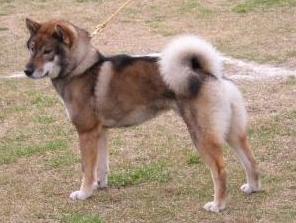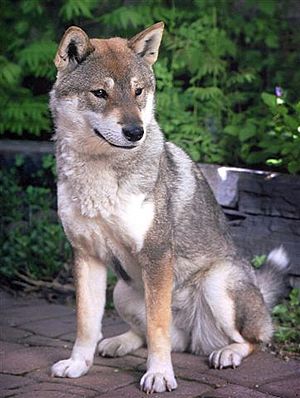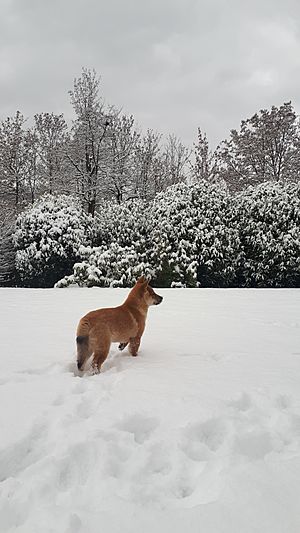Shikoku dog facts for kids
 |
||||||||
| Other names | Kochi-ken | |||||||
|---|---|---|---|---|---|---|---|---|
| Origin | Japan | |||||||
|
||||||||
| Domestic dog (Canis lupus familiaris) | ||||||||
The Shikoku Inu (also called Kōchi-ken) is a special dog breed from Japan. It comes from Shikoku island. In 1937, Japan officially recognized this dog as an important national treasure.
Contents
Shikoku's Place Among Japanese Dogs
The Shikoku is one of six dog breeds that are native to Japan. It is a medium-sized dog. It is bigger than the small Shiba Inu but smaller than the large Akita Inu. All these dogs belong to the Spitz family.
In the 1930s, a Japanese dog expert named Haruo Isogai studied all native Japanese dog breeds. He put them into three groups: large, medium, and small. The Shikoku is in the medium-sized group, often called Shika-inus. Other medium-sized Japanese dogs include the Kai Ken, the Hokkaido, and the Kishu Inu. These dogs look quite similar, with similar colors and only small differences in their size and shape.
The Shikoku also played a part in creating the Tosa dog breed. It was bred with European dogs like the Great Dane and English Mastiff to create the Tosa.
What Shikoku Dogs Are Like
Shikoku dogs are usually brave and very aware of what is happening around them. They can be a bit cautious with new things or people. They are sensitive but not easily scared.
These dogs are strong and athletic. They can run easily through mountains and rough areas. Their movements are quick and light, almost like they are bouncing.
Shikoku dogs make great friends for people who love to be active outdoors. However, training them to stay off-leash can be tricky. They have a lot of energy outside but are generally calm and quiet when they are indoors. The Shikoku is a very smart dog and learns quickly. They are not as stubborn as some other Japanese breeds, but they still need patient training.
Appearance
A Shikoku dog usually stands about 18 to 21 inches (46 to 55 cm) tall at the shoulder. They can have different coat colors:
- Sesame: This is a red color with black tips on the fur.
- Black and tan: Black fur with tan markings.
- Red: A reddish-brown color.
Sometimes, you might see a cream-colored Shikoku, but this color is very rare and not officially accepted for the breed. All these colors usually have some white fur on their belly, around their eyes, on their snout, and on their legs. This white marking is called "urajiro."
The Shikoku usually sheds its fur one or two times a year. They have a fairly thick coat, pointed ears, and a tail that curls over their back. Their body shape is typical for a spitz-type dog: a square body, a head shaped like a wedge, pointy triangular ears, and a thick, curled tail.
A male Shikoku dog usually weighs between 30 to 50 pounds (14 to 23 kg) and is about 20 inches tall. Females are a bit smaller, around 18.5 inches tall. This makes them a medium-sized dog.
Different Types of Shikoku Dogs
After efforts to rebuild the breed, three main types of Shikoku dogs developed. They were named after the areas in the Kochi prefecture where they came from: the Awa, the Hongawa, and the Hata. Over time, it became easier to travel to these remote areas. Because of this, the different types of Shikoku dogs started to mix.
Today's Shikoku dogs mostly come from the Hongawa and Hata types. The Awa type mostly disappeared. This happened because of the difficulties during World War II and because they were bred with other dogs.
See also
 In Spanish: Shikoku Inu para niños
In Spanish: Shikoku Inu para niños
- Dogs portal
- List of dog breeds



